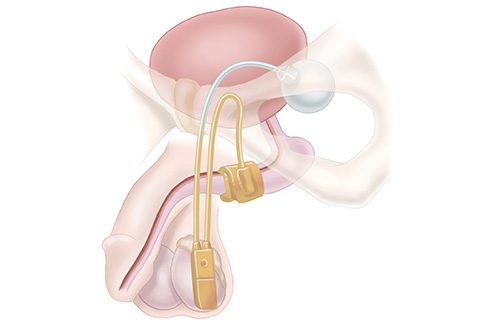
Urinary incontinence is a problem for men and women. It is caused by failure of the urinary sphincter, the muscle that controls your ability to hold your pee. This is common after treatment for prostate cancer, such as surgical removal of the prostate or radiation therapy. An Artificial Urinary Sphincter (AUS) can be used to stop this leakage of urine.
The device is implanted surgically, and is composed of 3 main parts:
- Urethral cuff: inflatable device that fits around the urethra. It is filled with fluid, and when closed, compresses the urethra to stop urine from flowing.
- Pump: a device that sits in the scrotum which allows to inflate and deflate the cuff.
- Balloon: holds the fluid, and allows it to move in and out of the cuff to either activate or deactivate the device. This balloon sits behind the abdominal muscles.
How it Works
In order to void, you will squeeze the pump, which is located in your scrotum. This will move fluid from the cuff to the balloon. The urethra will then be open and urine can easily pass. The cuff stays open for about 3 minutes, at which point it will close automatically.
Risks of the Procedure
- Infection
- Pain
- Bleeding
- Device failure or break down
- Injury to the urethra
- Continued leakage of urine
- Injury to other organs in the area
- Urinary tract infections or other bladder issues
After the Procedure
You will be in hospital overnight with a urinary or foley catheter draining your bladder. You will receive antibiotics as well as pain medication and fluids.
Your catheter will be removed before you go home.
Post-Surgical Discharge
- The device will be DEACTIVATED, and you will therefore still have leakage of urine. This is normal.
- You will be discharged with antibiotics medication as well as pain management and a stool softener.
- You may shower when you get home. No baths, hot tubs, or swimming for 2 weeks.
- No heavy lifting/straining/strenuous activities for 6 weeks
- You will see your urologist for activation approximately 6-8 weeks after surgery. You will be taught how to use the device at your follow up appointment.
Important
Other medical professionals need to know that you have an AUS. Please order a MedicAlert bracelet or necklace.
More Information
Please visit BC HealthLink for more information.
The following video may also be informative.
